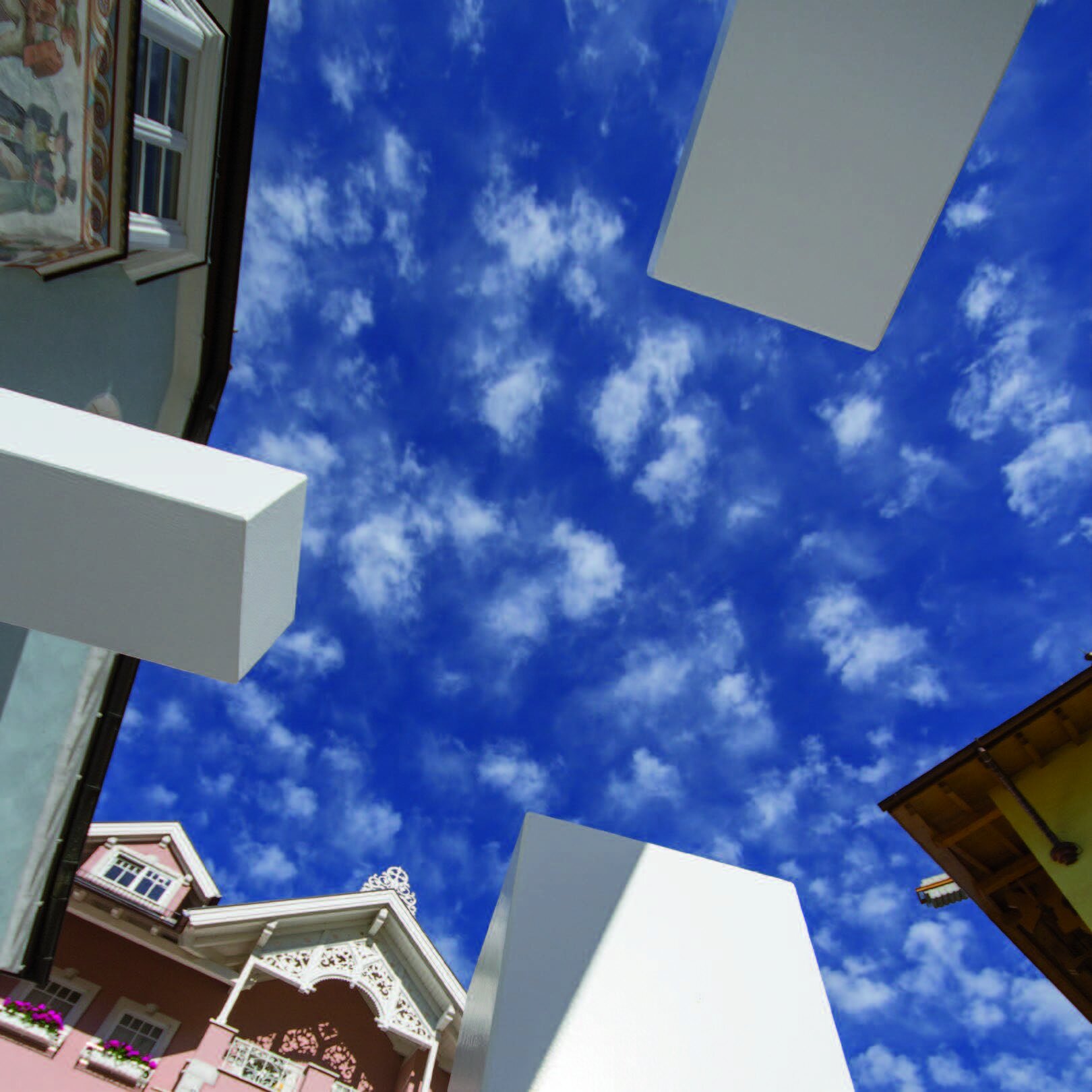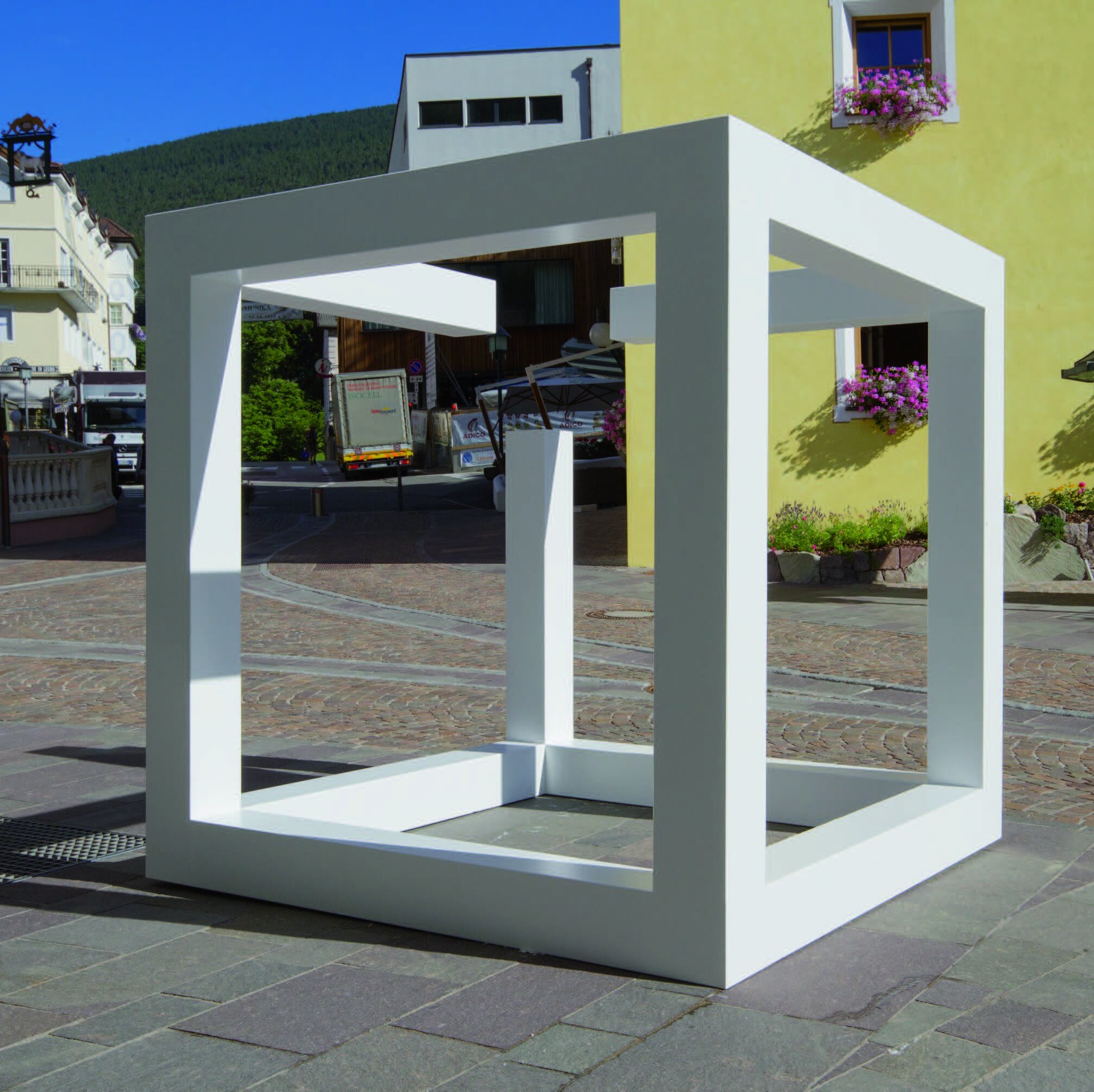
Esther Stocker
*1974, Italy
lives and works in Vienna, Austria
EN
In her work, Esther Stocker deals with the question of the perception of structure and space. The deconstruction of exact forms is the starting point for her photographic and video works, paintings, spatial installations and interventions on façades. Stocker develops her works as a system of geometric drawing and grid systems in black, white and grey. She also extends these into the third dimension and changes space and architecture through artistic interventions, whereby disturbances and optical breaks form an important component. The disturbances and breaks are often mi-nimal and cause shifted vague perceptual events that repeatedly demand the viewing of this apparent precision. In this way, the artist creates dynamic pictorial spaces that lose their supposedly clear pattern of order.
Esther Stocker designed a large white cube made of wooden beams for the pedestrian zone. The sculpture has the framework of a perfect cube, but one corner is missing. "The work is a homage to the unfinished," Stocker emphasises. For the artist, this opening or void is the most essential part of the sculpture. She distrusts powerful and absolute signs, she likes the idea of an absolute form being questioned. That is why she opens up the form and thereby grants it "an unexpected turn". Nevertheless, or precisely because of this, her seemingly unfinished form is irritating. Moreover, in its minimalism, it appears like a strange foreign body in an urban environment overloaded with signs and symbols. A sign, a form, a body, a three-dimensional geometric object, a sculpture: the work challenges our perception, but it also conditions and changes our view of public space.
IT
Nei suoi lavori, Esther Stocker si interroga sulla percezione di strutture e dello spazio. La decostruzione di forme esatte è il punto di partenza dei suoi progetti fotografici, dei suoi video, dei dipinti, del-le installazioni e degli interventi sulle facciate degli edifici. Stocker concepisce e sviluppa i suoi lavori come sistemi di segni geometrici e reticoli, nei colori nero, bianco e grigio, trasportandoli anche nella terza dimensione e ottenendo così attraverso un intervento artistico un’alterazione dello spazio e dell’architettura. Gli interventi di dis-turbo e di rottura formale ed ottica, spesso minimi e quasi impercettibili, alterano la percezione, rendendo così necessaria una ripetuta osservazione di questa presunta perfezione. L’artista crea spazi dinamici che tendono a perdere il loro assetto apparentemente ordinato e compiuto.
Esther Stocker ha ideato per la zona pedonale di Ortisei un gran-de cubo bianco realizzato con travi lignee. La scultura presenta la struttura di un cubo perfetto cui manca però un angolo. “L’opera è un omaggio all’incompiuto”, sottolinea Stocker. La componente fondamentale delle sue sculture è per l’artista proprio quest’apertura, questa mancanza. Stocker diffida da segni potenti e assoluti, le pia-ce piuttosto l’idea che anche una forma assoluta possa essere messa in discussione. Per questo motivo apre la forma, ottenendo “una svolta repentina ed inaspettata”. Tuttavia o forse proprio per questo motivo, la figura incompleta provoca una sensazione di irritazione. Inoltre, il minimalismo formale del cubo inserito entro un contesto urbano sovraccarico di segni e simboli lo fa sembrare un singolare corpo estraneo. Un segno, una forma, un corpo, un oggetto geometrico tridimensionale, una scultura: l’opera stimola e provoca la nostra percezione, condiziona e modifica però anche il nostro sguardo sullo spazio pubblico.
DE
Esther Stocker beschäftigt sich in ihrer Arbeit mit der Frage nach der Wahrnehmung von Struktur und Raum. Die Dekonstruktion exakter Formen ist für sie Ausgangspunkt der Foto- und Videoarbeiten, der Malereien, Rauminstallationen und Interventionen an Fassaden. Ihre Arbeiten entwickelt Stocker als System geometrischer Zeichen- und Rastersysteme in Schwarz-Weiß-Grau. Diese erweitert sie auch in die dritte Dimension und verändert durch künstlerische Eingriffe Raum und Architektur, wobei Störungen und optische Brüche einen wichtigen Bestandteil bilden. Die Störungen und Brüche sind oft minimal und verursachen verschobene vage Wahrnehmungsereignisse, die das Betrachten dieser scheinbaren Präzision wiederholt einfordern. So erzeugt die Künstlerin dynamische Bildräume, die ihr vermeintlich klares Ordnungsmuster verlieren.
Für die Fußgängerzone entwarf Esther Stocker einen großen weißen Kubus aus Holzbalken. Die Skulptur hat das Gerüst eines perfekten Würfels, doch eine Ecke fehlt. „Die Arbeit ist eine Hommage an das Unvollendete“, betont Stocker. Für die Künstlerin ist diese Öffnung oder Leerstelle der wesentlichste Teil der Skulptur. Sie misstraut mächtigen und absoluten Zeichen, ihr gefällt der Gedanke, dass eine absolute Form in Frage gestellt wird. Deshalb öffnet sie die Form und gewährt ihr dadurch „eine unerwartete Wendung“. Dennoch oder gerade deshalb irritiert ihre unvollendet wirkende Gestalt. Zudem erscheint sie in ihrem Minimalismus im von Zeichen und Symbolen überladenen urbanen Umfeld wie ein sonderbarer Fremdkörper. Ein Zeichen, eine Form, ein Körper, ein dreidimensionales geometrisches Objekt, eine Skulptur: die Arbeit fordert unsere Wahrnehmung heraus, sie konditioniert und verändert aber auch unseren Blick auf den öffentlichen (Um-)Raum.

